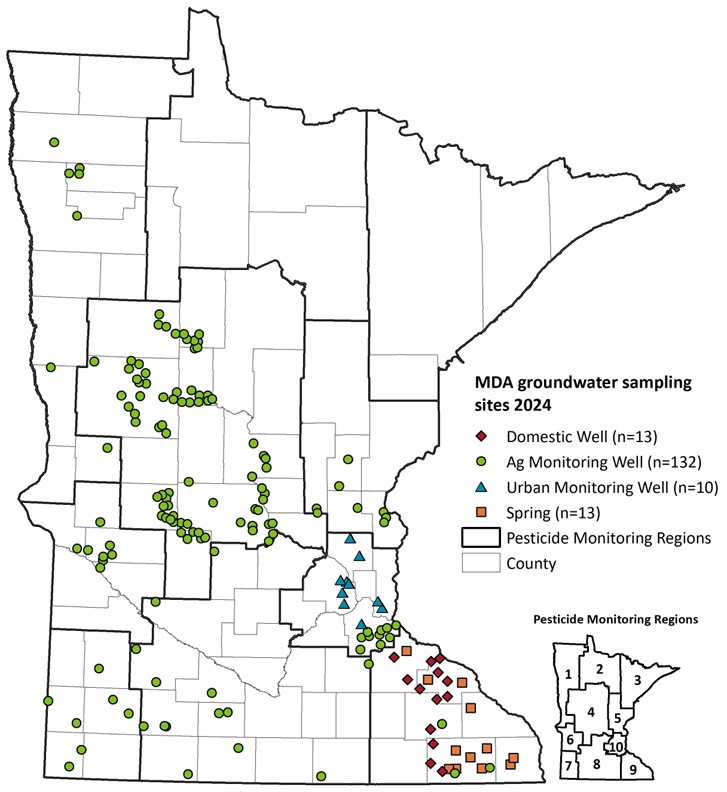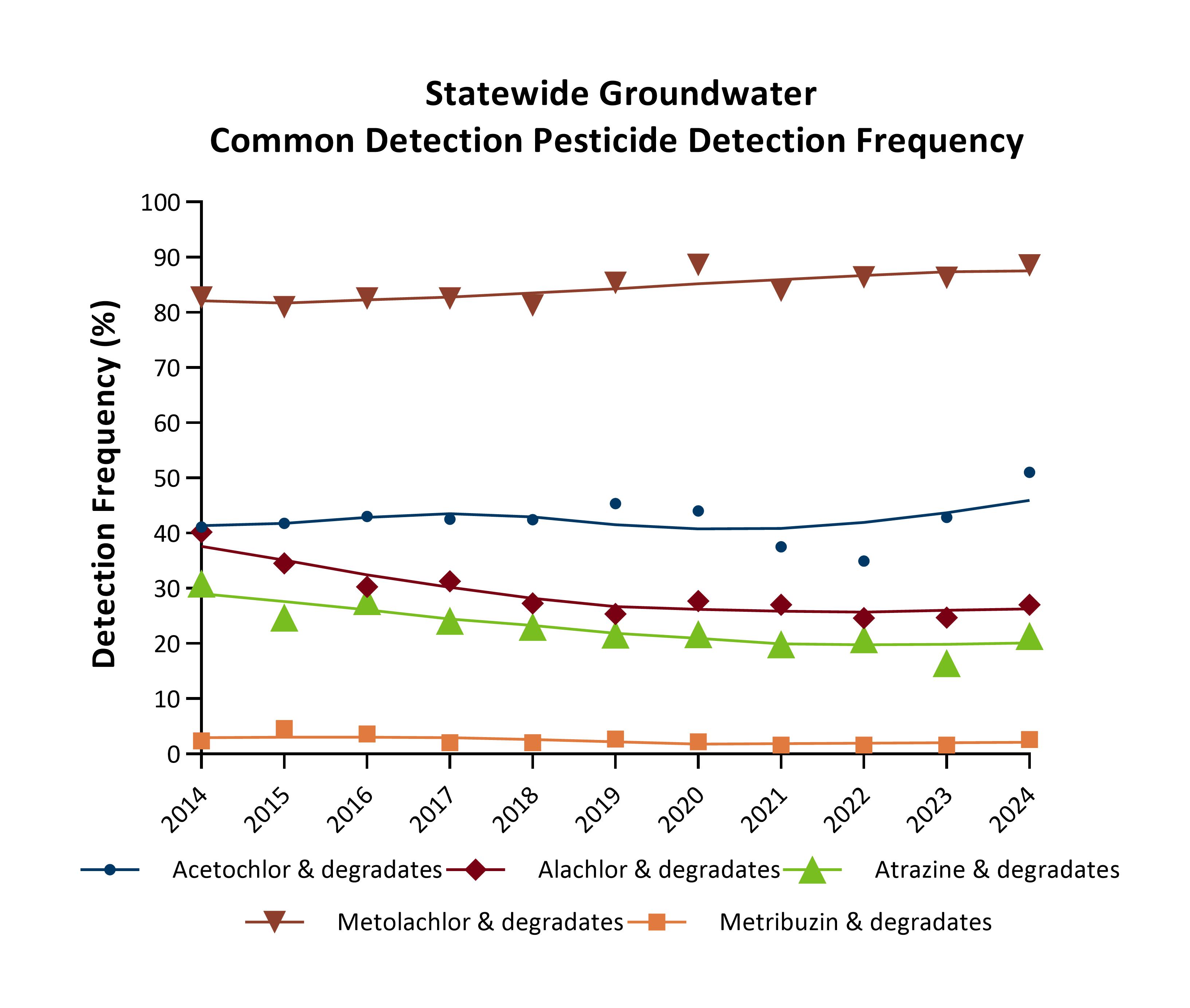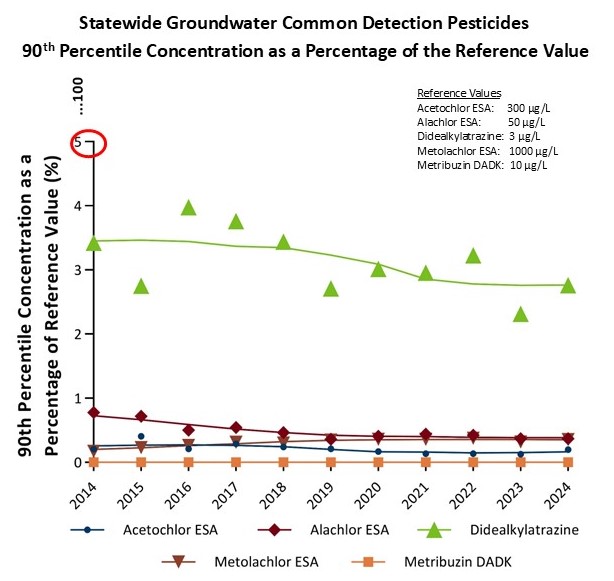The primary goal of the MDA's pesticide groundwater monitoring is to provide detailed information on the occurrence and concentrations of pesticides in Minnesota's groundwater resources. Protection of Minnesota's citizens and water resources from agricultural chemicals is the fundamental purpose of this goal. The program focus is monitoring vulnerable groundwater in the agricultural and urban areas of the state.

Background
In 1987, the Minnesota Legislature amended the Minnesota Pesticide Control Law. It directed the MDA to determine the impact of pesticides on the environment, including the impacts on surface water and groundwater.
In response to this charge, the MDA initiated a pesticide groundwater monitoring program in 1987 and in 1991, began surface water monitoring. The MDA has one of the most comprehensive pesticide monitoring programs in the country.
Groundwater Monitoring Results for 2024
In 2024, the MDA’s ambient monitoring program sampled 168 monitoring wells, naturally occurring springs and private drinking water wells throughout the state for pesticides.
142 were shallow monitoring wells.
13 were naturally occurring springs.
13 were private drinking water wells.
In total, 225 sample collection events resulted in 225 GC-MS/MS, 225 LC-MS/MS, and 71 GAG LC-MS/MS samples.
Fifty-five of the 185 pesticides or pesticide degradates analyzed were detected.
Pesticide degradates usually had higher detection frequencies compared to parent pesticides.
The greatest detection frequency for the parent pesticides, on an individual analyte basis, included: clothianidin (49%), bentazon (20%), fomesafen (18%), sulfentrazone (16%), and thiamethoxam (9%).
The greatest detection frequency for the pesticide degradates, on an individual analyte basis, included: metolachlor ESA (90%), metolachlor OXA (58%), acetochlor ESA (48%), alachlor ESA (29%), and dimethenamid ESA (21%).
Glufosinate, glyphosate, and AMPA were not detected in 71 groundwater samples. These analytes have not been detected in Minnesota groundwater by the MDA since analysis began. Glyphosate and AMPA analysis began in 2014, while glufosinate analysis began in 2022.
Fluazaindolizine, prothioconazole desthio, and pyroxasulfone M3 were the new analytes added in 2024.
Pyroxasulfone M3 was the only 1 of the 3 that was detected.
Clethodim sulfone, clethodim sulfoxide, flutriafol, and halosulfuron-methyl were detected for the first time in 2024.
Analysis for each analyte began in 2018, 2018, 2013 and 2010, respectively.
One sample from an agricultural monitoring well in Dakota County had a total cyanazine (summation of cyanazine and associated degradates) concentration greater than the chronic drinking water Health Risk Limit (HRL) of 1,000 nanograms per liter (ng/L).
Two samples from one spring in Goodhue County, as well as one monitoring well in Wilkin County, had total cyanazine concentrations greater than 50% of (but not exceeding) the chronic drinking water HRL of 1,000 ng/L.
Nine samples collected from monitoring wells in PMR 4 had concentrations of 4‑hydroxychlorothalonil greater than the drinking water Risk Assessment Advice (RAA) of 2,000 ng/L. Five additional samples had concentrations of 4-hydroxychlorothalonil greater than 50% of (but not exceeding) the RAA.
In addition to the ambient groundwater monitoring data presented in Section 2, the MDA monitored 26 private drinking water wells in Becker, Cass, Hubbard, and Wadena Counties in 2024 that were near ambient monitoring wells where elevated concentrations of 4-hydroxychlorothalonil were previously detected. One sample had a concentration of 4‑hydroxychlorothalonil greater than the drinking water RAA of 2,000 ng/L. Two additional samples had concentrations of 4-hydroxychlorothalonil greater than 50% of (but not exceeding) the RAA. These results are presented in Section 5.3.
Five monitoring wells were dry during the summer/fall sampling rounds in 2024 and were not sampled when scheduled.
Common Detection Pesticides
"Common detection" is an official state designation made by the MDA Commissioner of Agriculture and is defined as “detection of a pollutant that is not due to misuse or unusual or unique circumstances but is likely to be the result of normal use of a product or a practice” (Minn. Stat. § 103H.005, Subd. 5). Groundwater common detection status is a useful tool to communicate to all involved parties that the normal use of a product or practice has resulted in its presence in groundwater and triggers a proactive approach to focus limited resources on pesticides which may adversely impact Minnesota’s resources. Pesticides, and select degradates, that have been designated as “common detection” receive heightened scrutiny from the MDA during reporting of monitoring results. Acetochlor, alachlor, atrazine, metolachlor, and metribuzin are the current common detection pesticides. Atrazine, metolachlor, and metribuzin were designated in 2002. Acetochlor and alachlor were designated in 2003.
The graph below shows how frequently the five pesticides were found in groundwater samples. Detection frequency includes both the original pesticide and its breakdown products, known as degradates.

We use the 90th percentile to focus on the higher-end concentrations in the dataset. The 90th percentile value is greater than the concentrations found in 90% of groundwater samples, but lower than those in the top 10%. These values were then compared to reference levels for each pesticide. Reference values indicate the concentration at which a pesticide may pose a human health risk. The graph below shows the 90th percentile concentrations as a percentage of their respective reference values.

Data Availability and Future Work
All of the pesticide data collected as part of the MDA's ambient monitoring program is publicly available through the Water Quality Portal or the MDA Pesticide Water Quality Monitoring StoryMap. The MDA will continue to improve its program to expand monitoring to new locations and to include additional pesticide analytes, as resources and needs permit. The MDA is committed to maintaining its long-term data record to allow for continued assessment of the impacts of pesticides on groundwater from routine use.

